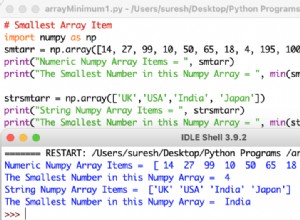Utilisez ndarray.diagonal
v = [max(c.diagonal(-i)) for i in range(b.shape[0])]
print(v) # [0, 13, 3, 6, -4]
Vous ne savez pas exactement à quel point cela est efficace compte tenu de l'indexation avancée impliquée, mais c'est une façon de le faire :
import numpy as np
a = np.array([8, 18, 5, 15, 12])
b = a[:, None] - a
# Fill lower triangle with largest negative
b[np.tril_indices(len(a))] = np.iinfo(b.dtype).min # np.finfo for float
# Put diagonals as rows
s = b.strides[1]
diags = np.ndarray((len(a) - 1, len(a) - 1), b.dtype, b, offset=s, strides=(s, (len(a) + 1) * s))
# Get maximum from each row and add initial zero
c = np.r_[0, diags.max(1)]
print(c)
# [ 0 13 3 6 -4]
MODIFIER :
Une autre alternative, qui n'est peut-être pas celle que vous recherchiez, consiste simplement à utiliser Numba, par exemple comme ceci :
import numpy as np
import numba as nb
def max_window_diffs_jdehesa(a):
a = np.asarray(a)
dtinf = np.iinfo(b.dtype) if np.issubdtype(b.dtype, np.integer) else np.finfo(b.dtype)
out = np.full_like(a, dtinf.min)
_pwise_diffs(a, out)
return out
@nb.njit(parallel=True)
def _pwise_diffs(a, out):
out[0] = 0
for w in nb.prange(1, len(a)):
for i in range(len(a) - w):
out[w] = max(a[i] - a[i + w], out[w])
a = np.array([8, 18, 5, 15, 12])
print(max_window_diffs(a))
# [ 0 13 3 6 -4]
Comparaison de ces méthodes avec l'original :
import numpy as np
import numba as nb
def max_window_diffs_orig(a):
a = np.asarray(a)
b = a - a[:, None]
out = np.zeros(len(a), b.dtype)
out[-1] = b[-1, 0]
for i in range(1, len(a) - 1):
out[i] = np.diag(b, -i).max()
return out
def max_window_diffs_jdehesa_np(a):
a = np.asarray(a)
b = a[:, None] - a
dtinf = np.iinfo(b.dtype) if np.issubdtype(b.dtype, np.integer) else np.finfo(b.dtype)
b[np.tril_indices(len(a))] = dtinf.min
s = b.strides[1]
diags = np.ndarray((len(a) - 1, len(a) - 1), b.dtype, b, offset=s, strides=(s, (len(a) + 1) * s))
return np.concatenate([[0], diags.max(1)])
def max_window_diffs_jdehesa_nb(a):
a = np.asarray(a)
dtinf = np.iinfo(b.dtype) if np.issubdtype(b.dtype, np.integer) else np.finfo(b.dtype)
out = np.full_like(a, dtinf.min)
_pwise_diffs(a, out)
return out
@nb.njit(parallel=True)
def _pwise_diffs(a, out):
out[0] = 0
for w in nb.prange(1, len(a)):
for i in range(len(a) - w):
out[w] = max(a[i] - a[i + w], out[w])
np.random.seed(0)
a = np.random.randint(0, 100, size=100)
r = max_window_diffs_orig(a)
print((max_window_diffs_jdehesa_np(a) == r).all())
# True
print((max_window_diffs_jdehesa_nb(a) == r).all())
# True
%timeit max_window_diffs_orig(a)
# 348 µs ± 986 ns per loop (mean ± std. dev. of 7 runs, 1000 loops each)
%timeit max_window_diffs_jdehesa_np(a)
# 91.7 µs ± 1.3 µs per loop (mean ± std. dev. of 7 runs, 10000 loops each)
%timeit max_window_diffs_jdehesa_nb(a)
# 19.7 µs ± 88.1 ns per loop (mean ± std. dev. of 7 runs, 100000 loops each)
np.random.seed(0)
a = np.random.randint(0, 100, size=10000)
%timeit max_window_diffs_orig(a)
# 651 ms ± 26 ms per loop (mean ± std. dev. of 7 runs, 1 loop each)
%timeit max_window_diffs_jdehesa_np(a)
# 1.61 s ± 6.19 ms per loop (mean ± std. dev. of 7 runs, 1 loop each)
%timeit max_window_diffs_jdehesa_nb(a)
# 22 ms ± 967 µs per loop (mean ± std. dev. of 7 runs, 10 loops each)
Le premier peut être un peu meilleur pour les petits tableaux, mais ne fonctionne pas bien pour les plus grands. Numba, par contre, est plutôt bon dans tous les cas.


